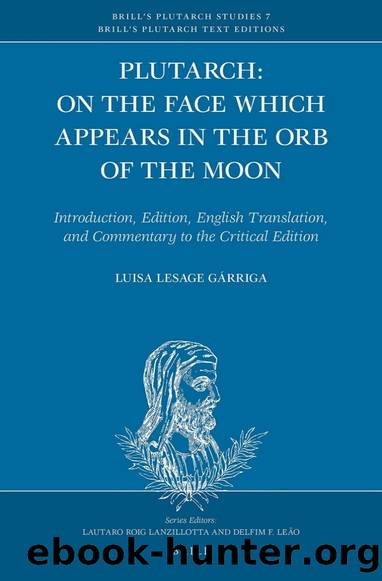Plutarch: On the Face Which Appears in the Orb by Luisa Lesage Garriga

Author:Luisa Lesage Garriga [Garriga, Luisa Lesage]
Language: eng
Format: epub
ISBN: 9789004458079
Amazon: 9004458077
Goodreads: 104908294
Published: 2021-05-03T13:52:50+00:00
Commentary to the Critical Edition
The commentary is organized to both illustrate and solve the difficulties within De facie. In general, a passage is included in the commentary when it presents one or more of the following aspects:
â The manuscripts have a physical lacuna or a lacuna is deducted by the context, affecting the understanding of a passage.
â The passage has serious syntactic or semantic difficulties.
â This edition proposes a new correction or conjecture.
Each heading normally keeps the following structure: first, in includes the text of the present edition, accompanied by the reading transmitted in the manuscripts; second, a summary of the problems that are involved in the passage; third, plausible solutions proposed by previous scholarship, and fourth, the plausible solution adopted in the present edition.1
With a view to avoiding the overload of footnotes in the commentary, previous proposals are referred to by means of the editorâs name. Their interventions in the text are easily traceable, since the section âEditores citatiâ provides full references. Differently, when emendations are not included in an edition but in specific studies, a full reference is provided in the footnotes.
920B 1
⦠ὠμὲν οá½Î½ Î£á½»Î»Î»Î±Ï ÏαῦÏα εἶÏεΠâÏá¿· Î³á½°Ï á¼Î¼á¿· μύθῳ ÏÏοÏήκει κá¼ÎºÎµá¿-
θέν á¼ÏÏινÎâ
EB
á½Î±Ï νοÏÏ Î»Î»Î±Ï E / ὠμὲν οá½Î½ Ïá½»Î»Î»Î±Ï B ÏαῦÏα εἶÏε. Ïá¿· Î³á½°Ï á¼Î¼á¿· μύθῳ
ÏÏοÏήκειΠκá¼ÎºÎµá¿Î¸á½³Î½ á¼ÏÏινÎ
The beginning of the treatise is plausibly lost.2 With most editions, I accept Bâs reading for the first sentence (ὠμὲν οá½Î½ ÏύλλαÏ), against the corrupted reading of E (á½Î±Ï νοÏÏ Î»Î»Î±Ï). Raingeard and Cherniss preferred to start directly with á½
ΣύλλαÏ; and Pohlenz, in his edition, maintained the corrupted form of E, preceded by the crux philologica, and suggested (in the apparatus) the conjecture á¼ÎºÎ¿á½»ÏÏμεν οá½Î½ ὠΣύλλαÏ.
Bâs reading, interestingly, coincides with the beginning of Quaest. conv. 3.4, which also starts by referring to the same Sulla: ὠμὲν οá½Î½ Î£á½»Î»Î»Î±Ï ÏαῦÏâ εἶÏεν. Bâs beginning might consequently be an attempt to correct the incomprehensible 1 Translation of singular terms is not provided unless the issue at stake is precisely the meaning of the words transmitted by the manuscripts.
2 L. Lesage Gárriga, Plutarchâs Moon, in preparation.
© Luisa Lesage Gárriga, 2021 | doi:10.1163/9789004458086_006
commentary to the critical edition
113
form of E into an existing form found elsewhere in Plutarchâs work.3 However, it must be kept in mind that the current beginning most probably was not the original beginning of De facie.
Eâs reading (á½Î±Ï νοÏÏ Î»Î»Î±Ï) could be explained as a corruption of ὠοá½Î½ followed by an erroneous repetition of the article: ὠοá½Î½ ὠΣύλλαÏ. Without the erroneous repetition, this construction is used elsewhere in Plutarch for the introduction of a character.4
The plausible loss of the beginning has caused different interpretations of the first sentencesâ syntax. The pronoun ÏαῦÏα could allude to the previous words, from the lost part of the treatise, thus functioning as object of the verb εἶÏε (â¦ Î£á½»Î»Î»Î±Ï ÏαῦÏα εἶÏε.); or the pronoun ÏαῦÏα could be part of Sullaâs following words, thus functioning as subject of the verbs ÏÏοÏήκει and á¼ÏÏιν, which would make the whole sentence as object of εἶÏε
Download
This site does not store any files on its server. We only index and link to content provided by other sites. Please contact the content providers to delete copyright contents if any and email us, we'll remove relevant links or contents immediately.
| Ancient & Classical | Medieval |
The Universe of Us by Lang Leav(14988)
The Sun and Her Flowers by Rupi Kaur(14433)
Adultolescence by Gabbie Hanna(8839)
Whiskey Words & a Shovel II by r.h. Sin(7945)
Love Her Wild by Atticus(7688)
Smoke & Mirrors by Michael Faudet(6116)
Wiseguy by Nicholas Pileggi(5651)
The Princess Saves Herself in This One by Amanda Lovelace(4901)
Love & Misadventure by Lang Leav(4785)
Memories by Lang Leav(4732)
Milk and Honey by Rupi Kaur(4686)
Bluets by Maggie Nelson(4460)
Too Much and Not the Mood by Durga Chew-Bose(4257)
Pillow Thoughts by Courtney Peppernell(4191)
Good morning to Goodnight by Eleni Kaur(4181)
The Poetry of Pablo Neruda by Pablo Neruda(4021)
Algedonic by r.h. Sin(3999)
HER II by Pierre Alex Jeanty(3555)
Stuff I've Been Feeling Lately by Alicia Cook(3397)
